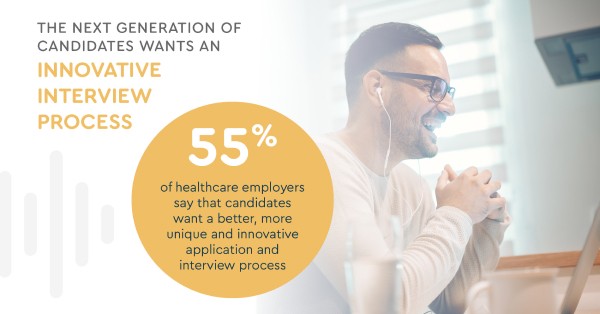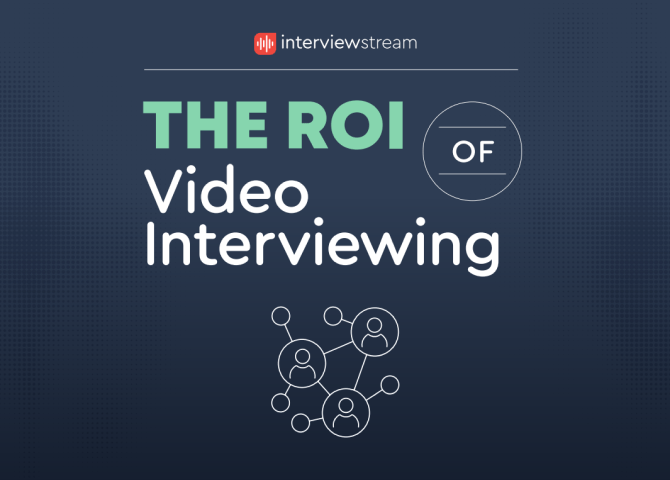Humanizing Healthcare Hiring: How to Optimize Your Recruiting Process to Attract More Talent

The rundown
- While 78% of employers felt they provided a great candidate experience, only 47% of those candidates agreed.
- A culture of caring begins with recruitment — and a more humanized hiring process will result in faster results and more satisfied candidates.
- This requires tackling common challenges like scheduling restrictions, long delays, and the logistical hassles of bringing candidates onsite.
- The right recruiting tech can help you tackle all of these problems to simplify and personalize your hiring practices.
Table of contents
- Start at the beginning
- Step 1: Overcome scheduling restrictions and logistical hassles
- Step 2: Minimize delays in the hiring process
- Step 3: Allow candidates to present themselves — beyond a piece of paper
- Step 4: Gather (and implement!) feedback
- Always be evolving
- About interviewstream
Start at the beginning
Treating your employees like people instead of cogs in a machine is more crucial than ever. In fact, it’s table stakes for any modern organization. And in the healthcare industry, it can literally mean life or death (after all, more engaged providers yield better patient outcomes).That supportive atmosphere must start with the candidate experience. It’s a crucial first impression that will have a significant impact on your odds of an accepted offer, as well as your reputation as an employer. According to a 2017 study, 78% of candidates believe their experience during the recruiting process is an important indicator of how a company treats its employees.Think you’re already doing a bang-up job? It’s still worth a closer look. Another study found that, while 78% of employers felt they provided a great candidate experience, only 47% of those candidates agreed.So, just as it’s important to screen candidates for the best fits who will improve and elevate your company, it’s critical show candidates that you have a welcoming workplace culture.Of course, that’s easier said than done. How do you convey compassion and humanize your hiring process to ensure candidates see the best in you — without bogging down your recruiters, hiring managers, or interviewers with a bunch of extra work?
Interested in our HR newsletter? Sign up below!
Sign up for our newsletter – we send out an email every 6 weeks which includes HR trends, industry-relevant knowledge, and the latest interviewing tips for recruiters and candidates.
Step 1: Overcome scheduling restrictions and logistical hassles
Setting up and conducting interviews takes time. That’s a fact of life — and skirting over it with shortcuts isn’t likely to do you any favors.
Still, the process must seek balance. Remember: In recruiting, as in many areas of business, more time spent on something doesn’t necessarily mean better results.So first, think critically about your interview process. Are you bringing candidates onsite two, three, or more times during the recruiting process? Are you keeping them in an interview for more than 45 or 60 minutes at a time? If so, why?As stated in Harvard Business Review, “The amount of time employers spend on interviews has almost doubled since 2009, according to research from Glassdoor. How much of that increase represents delays in setting up those interviews is impossible to tell, but it provides at least a partial explanation for why it takes longer to fill jobs now.”Studies have shown that longer or more abundant interviews don’t guarantee more valid results. Between the amount of time spent sitting in interviews and the difficulty of finding openings in everyone’s schedule, you could be wasting a lot of time on a process that’s not giving you a better outcome.

If any of this sounds familiar, consider talking to a recruiting consultant who can help you identify any pitfalls in your process and suggest ideas for streamlining it.Next, familiarize yourself with the latest recruiting tech that will help you implement a streamlined approach — with as little manual hassle as possible. Solutions that offer remote interviews and self-scheduling can greatly improve your recruiters’ and candidates’ experience, showing more respect for everyone’s time and minimizing the headaches of traveling and back-and-forth logistics conversations.Your candidates will appreciate the ways these techniques offer more flexibility of their schedule and traveling constraints, because you won’t be asking them to drop everything to accommodate an interview. This is especially important in healthcare, where everyone’s schedules may be beholden to appointments with patients, operating rooms, and more. Ultimately, this will also have a positive impact on how quickly your hiring process can progress — and that will make everyone happier.
Step 2: Minimize delays in the hiring process
Speaking of moving faster: According to a report by Health eCareers, the average time a job opening goes unfilled in healthcare organizations is almost 50 working days. That’s a lot of time wasted for your company, a lot of patients unseen, and if you’re trying to backfill an empty role or accommodate new growth, the long wait can result in burnout for the folks filling the gap until help arrives.But it doesn’t have to be that way. Modern recruiting software offers one-way video interviews, which put the power in candidates’ hands to move the screening timeline on their own terms. With it, applicants record themselves answering some prepared questions whenever it’s convenient for them.
“Hospitals need to rethink their recruitment strategies and incorporate time-saving technology into their recruiting plans.”
The process is simple: Applicants receive an email invitation to record a one-way interview, which can be done on virtually any device. You provide a deadline, but they can find their own time to get it done in that window — no mutual scheduling required. Our data shows that most will end up submitting something for you within 24 hours of receiving the request. You’ll see their submissions in your recruiting platform, where you can review and share them with other stakeholders.The efficiencies gained can mean a 58% reduction in time-to-offer, and allow applicants to take advantage of more speed in the hiring process — which can be a strong indicator that you’re prioritizing the respect candidates crave.
Step 3: Allow candidates to present themselves — beyond a piece of paper
Another benefit of one-way video interviewing is that it gives candidates an opportunity to show you who they really are, rather than simply tell you about themselves. People are more than the sum of their parts, and they’re definitely more than their resumes suggest. You can’t convey bedside manner or depth of clinical knowledge on a resume nearly as well as in spoken conversation, right?Additionally, this tool empowers candidates to take ownership of this early step in the screening process. Given the time and space to consider their answers to your questions and articulate themselves, without the arbitrary pressure imparted by hearing that empty air over the phone, applicants can present themselves in their best light with less awkwardness and greater flexibility.The videos will also yield accurate first impressions for hiring managers, who have provided a 90% approval rating for this process in our studies.
Source: “From the Frontlines of Hiring in Healthcare Today — Fireside Chat Recap“
Another area you can incorporate more honesty and transparency into your healthcare recruiting process? In the screening stage and beyond, the way you build your interviews matters. Make sure your questions encompass not just a candidate’s background and experience, but their overall skillsets and what’s important to them in terms of passion and professional development.You can invite interviewees to be more genuine by asking questions that dig deeper. For example: Instead of simply asking about the factual outcomes of a notable assignment, ask about its effects on their working relationships with other collaborators, what it helped them learn about their likes and dislikes for their role, or how memorable feedback from a patient or colleague has influenced the way they approach cases.Don’t ask more of the same “Tell me about an achievement you’re proud of” questions. Instead, try: “How do you rebound from setbacks that shake your confidence?” or “What has delighted you most about this profession, and how do you pursue that sense of delight in your everyday approach to work?”These types of conversations will foster much more introspection and provide better insights into the culture fits of potential employees. And with the right healthcare recruiting software, you don’t have to put the expectation to invent these questions onto your interviewers — a full library of them can be built into an easy-to-use system, ensuring minimal frustration for your team and greater consistency of experience among candidates.
Step 4: Gather (and implement!) feedback
After doing this work to improve the candidate experience and inject a little more personality (and flexibility) into your interview process, what’s the number one way you can almost guarantee it’s all for naught?Failing to gather feedback from the people who matter most: the candidates.Gathering input from your applicants is crucial to understanding how smoothly your hiring process is going. While it’s essential to understand what your recruiters and hiring managers think about it, you’ll have a big gap in your understanding of its effectiveness if you’re ignoring feedback from the other side of the table (or screen).This doesn’t have to be a super detailed process — but getting some idea of candidate sentiment can be really helpful in fine-tuning your healthcare recruiting strategy.Now, as you know, the recruiting process always leads to one of two outcomes: an offer or a rejection. And to get the best impression of the candidate experience you provide, you’ll want to request input from the people who fall into both of those categories.For those given an offer, this is simple. You can build a brief conversation with a recruiter into your onboarding process for new hires to ask them about their candidate experience and how you might be able to improve it (just make sure you invite honesty!).

For candidates who are not hired, it’s understandable to tread more lightly — but you can use this request as an opportunity to humanize this most painful part of the recruiting process. Especially for final-round candidates, consider giving them a call to deliver the news instead of simply firing off an impersonal email. Before you hang up, let them know you’d be happy to provide feedback if they would be interested in hearing it — and that you’d welcome their feedback on your recruiting process and how you can improve it as well.This effort, while requiring bit more time from your recruiters, will help candidates feel seen and respected even if you’re making an ask of them. As an added bonus, it can also prevent you from burning a bridge: Ending the process on friendly, mutually beneficial terms can also help you keep each other in mind for future opportunities, should this qualified candidate (after all, they made it all the way to your final stage!) be better suited for a different opening in your organization.This feedback gathering is especially important for candidates to whom you make an offer, but who end up declining it. When you receive a rejection from such a candidate, ask them for their honest feedback on the process and whether their candidate experience had any influence on their decision. Sometimes their input may be hard to hear, but it’s essential for improving your overall recruiting strategy and setting your organization up for success in the future.
Always be evolving
Have you conducted all of these steps on your journey to optimized healthcare recruiting practices? If so, congratulations!But also, there’s more work ahead.In healthcare, best practices change rapidly as new treatments, technologies, and research emerge. It’s crucial to stay ahead of this curve and dedicate plenty of attention to your organization – from your staff to updating your procedures accordingly. It’s the same in recruiting for this field, because you want to make sure you’re hiring the most qualified and effective talent to fill the open roles in your organization and ensure the best possible patient outcomes.For this reason, you should continuously reevaluate your process and interview questions based on the evolving needs of your colleagues and candidates. Additionally, consider tailoring these optimized approaches based on niche hiring areas to make yourself as attractive and specialized as possible in this highly competitive field for employment.
About interviewstream
interviewstream is an industry leading recruiting software company that helps you reach your top candidates more effectively. Our customers have completed over 3 million interviews using interview builder, interview on demand, interview scheduler, interview connect – and we’d love to help you as well. Talk to an expert today to learn how to get started.
Want a PDF version of this eBook?
Submit your email and we’ll send the eBook straight to your inbox.
The interviewstream platform
Speak to an expert today to learn how our remote interviewing solutions make hiring more effective.
About interviewstream
As companies transition to remote work, we exists to help recruiters and hiring teams ask the right questions every time, screen candidates faster, make scheduling easier and reach candidates everywhere. Using our remote interviewing platform, your team will have a complete view of the candidate in one location while also leveraging one of the leading platforms for online interviewing.
Table of contents



